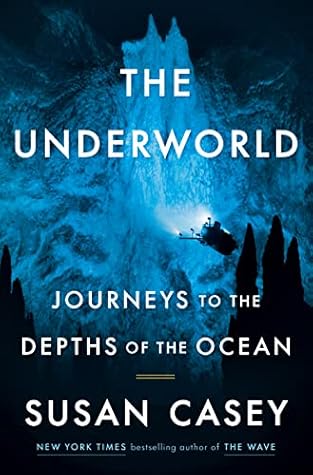More on this book
Community
Kindle Notes & Highlights
by
Susan Casey
Read between
October 19 - October 21, 2023
the deep ocean is considered to comprise the waters below two hundred meters, or approximately six hundred feet—the point at which sunlight essentially disappears. In this book, I have defined the deeper layers as the twilight zone (six hundred to thirty-three hundred feet), the midnight zone (thirty-three hundred to ten thousand feet), the abyssal zone (ten thousand to twenty thousand feet), and the hadal zone (twenty thousand to thirty-six thousand feet).
The science of measuring the seabed terrain is known as bathymetry—the submarine version of topography.
“The passion caused by the great and sublime in nature…is Astonishment,” wrote the eighteenth-century philosopher Edmund Burke, “and astonishment is the state of the soul, in which all its motions are suspended, with some degree of horror.”
Even now, when every last crater on the moon has been named and interactive three-dimensional maps of Mars can be viewed on an iPhone, 80 percent of the seafloor has never been charted in any kind of sharp detail. Yet the deep ocean—defined as the waters below six hundred feet—covers 65 percent of the earth’s surface and occupies 95 percent of its living space.
Our awareness of the ocean typically stops at its uppermost layer, known as the epipelagic (or sunlight) zone.
The deepest of them is the Mariana Trench, a fifteen-hundred-mile-long, forty-four-mile-wide gash in the seabed, near Guam. It’s home to the 35,876-foot Challenger Deep, the ocean’s absolute nadir. By comparison, Mount Everest is 29,029 feet high.
In the deep, there are creatures that breathe iron and creatures with glass skeletons and creatures that communicate through their skin. Some of its creatures can turn themselves inside out. They might have two mouths or three hearts or eight legs. Or their bodies might consist of a thousand little bodies, a coordinated army. At least one deep-sea creature squirts yellow light. Some have see-through heads. Even the most ethereal among them can handle pressures that would crush a Mack truck.
Now it’s apparent that nature runs as a massively interconnected system, with the deep sea as its motherboard.
The deep buffers our excess carbon (at least so far), drives the ocean’s circulation (and thus, climate), regulates the earth’s geochemistry (important, to put it mildly), and absorbs surplus heat (ditto)—to cite just a few of its services. Humming away in obscurity, it’s the foundation of the planet.
For every dollar the National Oceanic and Atmospheric Administration spends on ocean exploration and research, NASA gets a hundred and fifty.
The word abyss, translated from its Greek roots, means “without bottom.”
Bombs of every shape and vintage litter Oahu’s seafloor, as though tossed with abandon into a dumpster. And Hawaii isn’t the only place where you can find a submerged arsenal. Between 1919 and 1972, what the military blithely called “sea disposal” was standard practice. Globally, millions of tons of live munitions were sunk.
No one knew if the bombs were leaching their contents, if chemical agents might one day waft through the waters along Waikiki Beach, or end up in somebody’s sushi. When exposed to seawater, mustard gas forms a concentrated gel: it remains active in the ocean for a tenaciously long time. (Fishermen are regularly burned by contact with mustard shells that surface in their nets.) According to a 2007 U.S. congressional report, more than sixty-one thousand mustard bombs and mortar shells and 1,038 tons of sulfur-based chemical warfare agents were tipped into Hawaiian waters. They were joined by
...more
what drew me to the ocean was the fact that enchantment was still available underwater.
“Just as scientists have discovered through ever more powerful telescopes that stars number in the billions,” the evolutionary biologist Mitchell Sogin has noted, “we are learning through DNA technologies that the number of marine organisms invisible to the eye exceeds all expectations and their diversity is much greater than we could have imagined.”
“We’re at a point in time where we have a choice,” she said. “Here’s the thing: We didn’t know before. Fifty years ago, there was so much we didn’t know. We are now better prepared, armed with the superpower of knowledge. I tell kids, ‘Be glad that you’re a twenty-first-century human. Imagine if you didn’t have the facts about what the problems are. Imagine if you didn’t have the solutions. But you have both.’ ”


